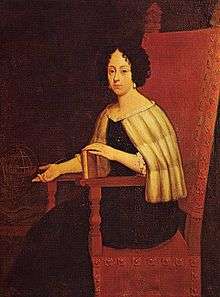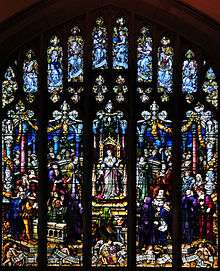Elena Cornaro Piscopia
| Elena Cornaro Piscopia | |
|---|---|
 | |
| Born |
5 June 1646 Ca' Loredan, Venice, Republic of Venice[1] |
| Died |
26 July 1684 (aged 38) Padua, Republic of Venice[2] |
| Nationality | Venetian[3] |
| Alma mater | University of Padua |
| Academic advisors |
Carlo Rinaldini (philosophy) Felice Rotondi (theology) |
Elena Lucrezia Cornaro Piscopia, also Helen Cornaro (Italian: [pisˈkɔːpja]; 5 June 1646 – 26 July 1684), was a Venetian philosopher of noble descent, who was one of the first women to receive an academic degree from a university[4] and in 1678 she became the first woman in the world to receive a Ph.D. degree.[5]
Early life
Elena Cornaro Piscopia was born in the Palazzo Loredan, at Venice, Republic of Venice on 5 June 1646. She was the third child of Gianbattista Cornaro-Piscopia, and his mistress Zanetta Boni. Her mother was a peasant and her parents were not married at the time of her birth.[3][6] As such, Lady Elena was not technically a member of the Cornaro family by birth, as Venetian law barred illegitimate children of nobles from noble privilege, even if recognized by the noble parent. Worse for Zanetta's case, she was from an extremely poor peasant family. Zanetta had likely fled to Venice in order to escape starvation, and soon found herself the mistress of a member of one of the most powerful noble dynasties in the Republic. Gianbattista and Zanetta married officially in 1654, but his sons were barred from noble privilege, which galled Gianbattista.
In 1664, her father was chosen to become the Procuratore di San Marco de supra, the treasurer of St. Mark's, a coveted position among Venetian nobility. At that point, her father was second only to the Doge of Venice in terms of precedence.[7] Because of this connection, Lady Elena was prominent in the Marriage of the Sea celebration, even though she was born illegitimate. Her father tried to arrange betrothals for her several times. She rebuffed each man's advances, as she had taken a vow of chastity at the age of eleven.[3]
In 1665 she took the habit of a Benedictine Oblate without, however, becoming a nun.[3]
Education
As a young girl, Lady Elena was seen as a prodigy. By the advice from Giovanni Fabris, a priest who was a friend of the family, she began a classical education. She studied Latin and Greek under distinguished instructors, and soon became proficient in these languages at the age of seven, including French and Spanish.[3] She also mastered Hebrew, Spanish, French and Arabic, earning the title of "Oraculum Septilingue". Her later studies included mathematics, philosophy, and theology.
Elena came to be an expert musician. In addition to mastering the sciblis of her time—which means she mastered almost the entire body of knowledge—Elena mastered the harpsichord, the clavichord, the harp, and the violin. Her skills were shown by the music that she composed in her lifetime.
In her late teens and early twenties, she became interested in physics, astronomy, and linguistics. Carlo Rinaldini, her tutor in philosophy, and at that point the Chairman of Philosophy at the University of Padua, published a book in Latin centering on geometry. The book was dedicated to a twenty-two year old Elena in 1668. When her main tutor, Fabris, passed away, she became even closer to Rinaldini, who took over her studies.[3]
Career
In 1669, she translated the Colloquy of Christ by Carthusian monk Giovanni Lanspergio from Spanish into Italian. The translation was dedicated to her close friend and confessor, Fr. Gianpaolo Oliva. The volume was issued in five editions in the Republic from 1669 to 1672. She was invited to be a part of many scholarly societies when her fame spread and in 1670 became president of the Venetian society Accademia dei Pacifici.[8][9]
Upon the recommendation of Carlo Rinaldini, her tutor in philosophy, Felice Rotondi, petitioned the University of Padua to grant Cornaro the laurea in theology.[10] When Gregorio Cardinal Barbarigo, the bishop of Padua, learned that she was pursuing a degree in theology, he refused on the grounds that she was a woman.[10] However, he did allow for her to get a degree in philosophy and after a brilliant course of study received the laurea in Philosophy.[10] The degree was conferred on 25 June 1678, in Padua Cathedral in the presence of the University authorities, the professors of all the faculties, the students, and most of the Venetian Senators, together with many invited guests from the Universities of Bologna, Perugia, Rome, and Naples. The Lady Elena spoke for an hour in classical Latin, explaining difficult passages selected at random from the works of Aristotle. She was listened to with great attention, and when she had finished, she received plaudits as Professor Rinaldini proceeded to award her the insignia of the laurea, the book of philosophy, placing the wreath of laurel on her head, the ring on her finger, and over her shoulders the ermine mozetta. This scene is illustrated in the Cornaro Window in the West Wing of the Thompson Memorial Library at Vassar College.

The last seven years of her life were devoted to study and charity. She died at Padua in 1684 of tuberculosis, was buried in the church of Santa Giustina at Padua, and her statue was placed in the university.
Legacy
Her death was marked by memorial services in Venice, Padua, Siena, and Rome. Her writings, published at Parma in 1688, include academic discourses, translations, and devotional treatises. In 1685 the University of Padua caused a medal to be struck in her honour. In 1895 Abbess Mathilda Pynsent of the English Benedictine Nuns in Rome had Elena's tomb opened, the remains placed in a new casket, and a suitable tablet inscribed to her memory.
The book by Jane Smith Guernsey, entitled The Lady Cornaro: Pride and Prodigy of Venice, published in 1999, is the first full-length study of the life of Lady Elena.
Works
- Lettera overo colloquio di Christo N. R. all'anima devota composta dal R. P. D. Giovanni Laspergio in lingua spagnola e portata nell'italiana, Venetia, Giuliani, 1669
- Helenae Lucretiae Corneliae Piscopiae opera quae quidem haberi potuerunt, Parmae, Rosati, 1688
See also
References
- ↑ The Republic did not fall until 1797. Source: Logan, Oliver Culture and society in Venice, 1470-1790: the Renaissance and its heritage, Batsford 1972
- ↑ Padua was annexed to the Republic of Venice in 1405, and was a part of the Republic's territories on the mainland until its fall in 1797. Source: J. J. Norwich, A History of Venice, p. 269
- 1 2 3 4 5 6 Guernsey, Jane Howard.The Lady Cornaro: Pride and Prodigy of Venice (1999; College Avenue Press).
- ↑ Paul F. Grendler (1988). John W. O'Malley, ed. Schools, Seminaries, and Catechetical Instruction, in Catholicism in Early Modern History 1500-1700: A Guide to Research. Center for Information Research. p. 328.
- ↑ "Elena Lucrezia Cornaro Piscopia". Agnesscott.edu. Retrieved 2013-09-05.
- ↑ Gregersen, Erik. "Elena Cornaro". Encyclopædia Britannica Inc. Retrieved 17 April 2014.
- ↑ Guernsey, Jane (1991), Ch. 1
- ↑ Battagia, Michele (1826). Delle accademie veneziane dissertazione storica di Michele Battagia (in Italian). dalla tipografia di Giuseppe Picotti.
- ↑ Guernsey, Ch. 8 (pg. 101)
- 1 2 3 "Elena Lucrezia Cornaro Piscopia" (in Italian). Università degli studi di Padova. Retrieved 22 January 2016.

- Vassar College Library Website
Sources
- Derosas, Renzo (1983). "CORNER, Elena Lucrezia". www.treccani.it (in Italian). Dizionario Biografico degli Italiani. Retrieved 22 January 2016.
- Guernsey, Jane Howard.The Lady Cornaro: Pride and Prodigy of Venice (1999).
External links
| Wikimedia Commons has media related to Elena Cornaro Piscopia. |